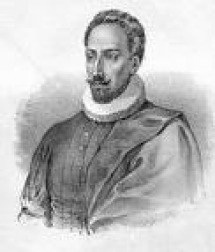Biography
Cervantes!
Cervantes:
1.Wrote Don Quixote.
2. His literature was a crowning achievement for the Golden Age.
3. Don Quixote was hailed one of the greatest literary works of all time
4. He presented the dual nature of a Spanish character in his works.
5. He believed that visionary dreams and the hard work of reality and necessary to the human condition.
Miguel de Cervantes was born in Alcala de Hanares on September 29, 1547. He was baptized on October 9th. Little is known about Cervante's early years. It seems he spent most of his childhood years moving from town to town with his family. During this time, he met Catalina de Parez. The couple fell madly in love and planned to run a way together. Sadly, her father found out about their plans, and forbade Josefina from ever seeing Cervantes again. In Toledo, Esquivias, on December 12, 1584, he married the much younger Catalina de Salazar y Palacios whose uncle Alonso de Quesada y Salazar is said to have inspired Don Quixote. During the next 20 years he led a nomadic existence, working as a purchasing agent for the Spanish Armada, and as a tax collector. He suffered a bankruptcy, and was imprisoned at least twice for irregularities in his accounts. Between the years 1596 and 1600, he lived primarily in Seville. In 1606, Cervantes settled permanently in Madrid, Spain; where he remained for the rest of his life. In 1585, Cervantes published his first major work, La Galatea, a romance, at the same time that some of his plays, now lost except for El trato de Argel and El cerco de Numancia, were playing on the stages of Madrid. La Galatea received little contemporary notice, and Cervantes never wrote the continuation for it. Cervantes next turned his attention to the drama, hoping to derive an income from that source, but the plays which he composed failed to achieve their purpose. Aside from his plays, his most ambitious work in verse was Viaje del Parnaso, an allegory which consisted largely of a rather tedious though good-natured review of contemporary poets. Cervantes himself realized that he was deficient in poetic gifts. Cervantes has been declared an Old Christian, New Christian, secularist, and Christian humanist.
Cervantes died in Madrid on April 23, 1616. In honour of the day Cervantes and William Shakespeare died, UNESCO established April 23 as the International Day of the Book. The Encyclopedia Hispanica claims that the date widely quoted as Cervantes' date of death, namely April 23, is actually the date on his tombstone which, in accordance with the traditions of the time, would be the date of his burial rather than the date of his death. If this is true, then, according to Hispanica, it means that Cervantes probably died on April 22 and was buried on April 23. Of his burial-place nothing is known except that he was buried, in accordance with his will, in the neighboring convent of Trinitarian nuns. Isabel de Saavedra, Cervantes' daughter, was supposedly a member of this convent. A few years afterwards the nuns moved to another convent and carried their dead with them. But whether the remains of Cervantes were included in the removal or not no one knows, and the clue to their final resting place is now lost beyond all hope.
Cervante's Novels:
1.La gitanilla (The Gypsy Girl)
2.El amante liberal (The Generous Lover)
3.Rinconete y Cortadillo La española inglesa (The English Spanish Lady)
4.El licenciado Vidriera (The Lawyer of Glass)
5.La fuerza de la sangre (The Power of Blood)
6.El celoso extremeño (The Jealous Old Man From Extremadura)
7.La ilustre fregona (The Illustrious Kitchen-Maid)
8.Novela de las dos doncellas (The Two Damsels)
9.Novela de la señora Cornelia (Lady Cornelia)
10.Novela del casamiento engañoso (The Deceitful Marriage)
11.El coloquio de los perros (The Dialogue of the Dogs)
In a village of La Mancha, the name of which I have no desire to call to mind, there lived not long since one of those gentlemen that keep a lance in the lance-rack, an old buckler, a lean hack, and a greyhound for coursing. An olla of rather more beef than mutton, a salad on most nights, scraps on Saturdays, lentils on Fridays, and a pigeon or so extra on Sundays, made away with three-quarters of his income. The rest of it went in a doublet of fine cloth and velvet breeches and shoes to match for holidays, while on week-days he made a brave figure in his best homespun. He had in his house a housekeeper past forty, a niece under twenty, and a lad for the field and market-place, who used to saddle the hack as well as handle the bill-hook.
In 1569 the cerventes traveled to Italy to serve in the household of an Italian nobleman, and joined the Spanish army a year later. He fought bravely against the Turks at the Battle of Lepanto in 1571, where he received serious wounds and lost the use of his left hand. After a lengthy period of recovery and further military duty, he departed Italy and Spain in 1575, only to be captured during the return journey by Barbary pirates. He was taken to Algiers and imprisoned for five years, until Trinitarian friars paid a considerable sum of money for his ransom. This experience was a turning point in his life, and numerous references to the themes of freedom and captivity later appeared in his work.


